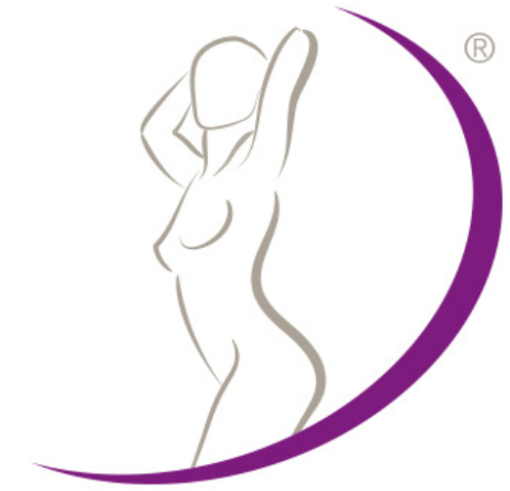- Confide in us
- Certified plastic surgeon
- 25 years of experience
- Quality over quantity
- Reliable aftercare
- Confide in us
- Certified plastic surgeon
- 25 years of experience
- Quality over quantity
- Reliable aftercare

For over 20 years, we have been guiding and advising women in their decision to undergo breast augmentation.
During our consultations, the same questions about breast augmentation often arise. That’s why we have compiled the most frequently asked questions about breast augmentation for you on this page.
Because every patient, every body, every breast is unique, you can address all your personal questions about breast augmentation during our comprehensive consultation.
- We welcome you with:
- 25 years experience in breast augmentations and breast lifts
- Extensive consultation, guidance and postop care
- Natural results
- High-quality breast implants
- Small incision - minimal scar
- Pain-free and quick recovery
- General anesthesia in day clinic (home the same day)
- Safe high-tech operating theatre
- Dedicated team, paramedics and anesthesist
- Good reviews and satisfaction
General questions about breast augmentation
1. What is a breast augmentation?
A breast augmentation is a surgical procedure that corrects the size and shape of the breasts using silicone implants and/or the patient’s own fat tissue.
Read all further information about breast augmentation here.
2. Why or when should you get a breast augmentation? Am I a good candidate for breast augmentation?
Why do women choose breast augmentation?
There are several reasons why women choose breast augmentation, such as:
1. Dissatisfaction with breast size:
Some women naturally have small breasts and feel that their size does not match their body shape or desired body image. Breast augmentation can help achieve the desired volume and create a more feminine figure.
2. Dissatisfaction with breast shape and volume:
Breasts can lose firmness and volume due to pregnancy, breastfeeding, weight fluctuations, or aging.
During pregnancy, the breasts enlarge due to the growth of milk glands, but after pregnancy and breastfeeding, the tissue shrinks back. Many women miss the shape and fullness of their breasts from before or even during pregnancy.
If your breasts have also become saggy after these changes, a breast lift – with or without implants – can be the solution for a more beautiful, youthful result.
3. Uneven breasts (asymmetry):
Although breast asymmetry is completely normal, breast augmentation may be considered if the difference in size or shape between the breasts is clearly visible and leads to feelings of discomfort or insecurity.
3. Do I also need a breast lift? Breast augmentation and/or breast lift?
A frequently asked question from patients considering breast augmentation is whether they also need a breast lift.
Read more here about the cases in which a breast lift with or without implants may be recommended.
4. Scar breast augmentation: Where is the scar or incision located in a breast augmentation?
Possible incisions for a breast augmentation
We distinguish the following incision methods in breast augmentation:
- through the natural breast fold at the bottom of the breasts (inframammary incision)
- through the armpit (transaxillary incision)
- through the nipple (peri-areolar incision)
- through the navel (transumbilical TUBA)
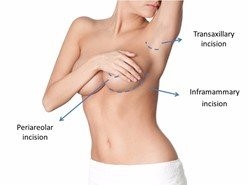
The most commonly used method is the one where the incision and scar from the breast augmentation are placed in the natural breast fold at the bottom of the breasts. This has several advantages.
Advantages of the incision in the natural breast fold:
- Less visible scar: The scar in the natural breast fold is less noticeable than in the armpit or nipple.
- Better visibility during surgery: The plastic surgeon has a clear view of the breast cavity (“pocket”) where the breast implant is placed, allowing this pocket to be perfectly tailored.
- Minimal incision: With the latest generation of Ergonomix2 Joy implants, an even smaller incision (“minimal scar”) is possible.
Disadvantages of incisions through the nipple, armpit, or navel:
- Incision around the nipple (peri-areolar): The major disadvantage of this method is that it involves cutting through breast and glandular tissue, which can lead to reduced nipple sensitivity and disruptions in later ultrasound or mammogram exams.
- Incision in the armpit (transaxillary): The downside of this incision is that the greater distance from the armpit to the breast can lead to more difficult-to-manage bleeding. Additionally, it becomes harder to position the implant properly because there is no clear view of the breast cavity. Poor healing of the scar in the armpit may also become visible in swimsuits or sleeveless clothing. If problems arise, a new incision (and thus scar) will still be needed.
- Incision in the navel (transumbilical TUBA): This technique is used exclusively for saline implants. The distance of the incision from the breast also negatively affects bleeding control and proper positioning of the implant.
5. Scar after breast augmentation: What does the scar look like after a breast augmentation? Will the scar be noticeable?
Minimal scar breast augmentation:
For many women, achieving a minimal scar is a key goal in breast augmentation. Several factors contribute to achieving a minimal scar:
1. Small incision for a smaller scar:
A smaller incision (“minimal scar”) automatically means a smaller scar. Thanks to the latest generation of breast implants, which are flexible and highly compressible, it is possible to make an incision of only 2.5 cm in the breast fold. This is almost half the size of an incision in a classic breast augmentation, resulting in a more subtle scar.
2. Strategic placement of the incision:
The incision is usually placed in the natural breast fold at the bottom of the breast. This location ensures that the scar is less visible compared to incisions in the armpit or around the nipple.
3. Modern surgical techniques:
By using the latest surgical techniques, such as “Preservé breast augmentation” (also see “Faster recovery after breast augmentation“), internal trauma and bleeding are minimized. This not only reduces the risk of excessive scar formation but also leads to faster recovery and less pain after the procedure.
4. Careful aftercare for optimal scar healing:
Proper aftercare is essential for optimal scar healing. This includes correctly cleaning the wound, wearing a supportive sports bra, and following our guidelines to prevent complications. After the surgery, we offer a series of (free) follow-up appointments, which are crucial for early detection and treatment of issues like abnormal scarring.
In most cases, the scar will have faded to a nearly invisible skin-colored line after a year, as shown in this photo of a scar about one year after breast augmentation.
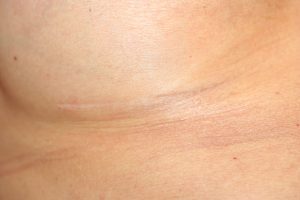
6. Will my breasts still feel and look natural? Will my breasts look fake? Will the implant be visible when I lie down? Will I feel the implant? Does the breast implant feel hard? Will everyone notice that I had a breast augmentation?
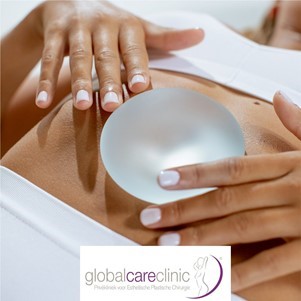
Will my breasts still feel and look natural? Will I feel the implant? Does the breast implant feel hard? Will the implant be visible when I lie down?
- We only use the latest generation of silicone breast implants, which are virtually indistinguishable from natural breasts in feel and appearance.
- These implants feel soft and supple, just like real breasts.
- They also adjust beautifully to your body’s movements: when you lie down, they take a rounder shape, and when you stand, they take on a naturally shaped teardrop form.
- This type of breast implant provides a very natural result.
- A bonus is that this type of breast implant does not need to be placed fully under/behind the muscle, which means the breast augmentation will cause much less or even no pain.
Will everyone notice that I had breast augmentation? Will my breasts look fake?
- Most of our patients choose a subtle, natural-looking breast augmentation, and this is also our specialty.
- In our breast augmentations, the focus is on classy, harmonious results that perfectly match your body. This way, the result remains natural without looking “fake.”
- That’s why we spend a lot of time during our detailed breast augmentation consultation choosing the right implant size. We do this in part by showing comparable before-and-after photos to give you a good idea of how your breasts will look after the surgery.
- An additional benefit is that there is much less pain and risk of complications when the implant size isn’t overly large and fits well with the body.
The following photos by Roxana Alvarez show how, with a natural size (295cc ergonomic), you can still create different looks – from a subtle curve to a more pronounced décolletage – depending on your preference and/or the occasion.
How will my breasts look after my breast augmentation?
- The final result depends, on the one hand, on your personal choice of size (amount of extra volume) and shape of the implants, but on the other hand, it also depends on your own natural breast tissue.
- It is therefore important to know that a certain number of cc (volume) does not always produce the same result for different patients, as the outcome is also dependent on the amount of natural breast tissue you have.
- For this reason, we spend a lot of time during the consultation measuring and mapping the existing breast tissue.
When will I see the final result of my breast augmentation?
The final result is usually visible after about six weeks.
7. How much does a breast augmentation cost? How expensive is a breast augmentation?
A breast augmentation is already possible from €3630 including VAT. Click here to go further to our prices for a breast augmentation and compare what is included in our prices.
8. Can I still breastfeed after a breast augmentation?
Yes, you can still breastfeed after a breast augmentation.
After a standard breast augmentation, where the incision is made under the natural breast fold, the glandular tissue and milk ducts remain intact, so the ability to breastfeed is not affected. An incision in the nipple, however, may impact the success of breastfeeding.
9. Can I still have breast exams after breast augmentation? Mammogram, ultrasound after breast augmentation?
Yes, breast examinations are still possible after breast augmentation with implants, and regular screenings are essential for breast cancer prevention.
Mammograms, MRIs, and ultrasounds can be performed without issues, but it’s important to inform the radiologist beforehand that you have breast implants.
In fact, (with a subfascial placement of the breast implant) it will even be easier to detect abnormalities, such as lumps, because the glandular tissue lies neatly on top of the implant, as clearly seen in this photo.
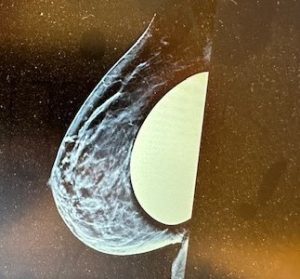
10. Is breast augmentation reimbursed? When is breast augmentation covered?
In Belgium and the Netherlands, breast enlargement is generally not reimbursed by health insurance, as it is usually considered an aesthetic procedure.
In some cases of medical necessity (e.g., reconstruction after breast cancer), reimbursement may be available. It is best to contact your health insurer for more information.
What is a breast augmentation with fat? What is a hybrid breast augmentation?
- A breast augmentation with fat (lipofilling) is a breast enlargement using your own fat tissue instead of silicone breast implants.
- A hybrid breast augmentation is a breast enlargement with breast implants combined with your own fat tissue, usually as a “touch-up.”
How does a breast augmentation with fat work?
A breast augmentation with fat involves a form of “lipofilling” where liposuction is first performed to remove excess fat from other areas of the body. This fat is then injected into the breasts.
Natural results
A breast augmentation with fat is often chosen by women looking for a more natural result.
However, a breast augmentation with the latest generation breast implants can also provide very natural results, with the difference from a real breast being hardly noticeable or visible, while avoiding the drawbacks of fat transfer breast augmentation.
Disadvantages of breast augmentation with fat
While breast augmentation with fat offers some advantages in certain situations, there are a few disadvantages to consider:
1. Limited enlargement
Compared to breast implants, the volume of enlargement that can be achieved with your own fat is often very limited. At best, you can only increase by one bra cup size. This makes the technique less suitable for women who want a larger increase.
2. No choice of shape, size, and profile
With a breast augmentation with fat, you cannot precisely choose the shape, size, and profile as you can with a breast implant. This limits the choice of the desired aesthetic result.
3. Available fat tissue
A breast augmentation with fat is only possible if there is enough usable fat tissue available to harvest from other areas of the body.
4. Unpredictable result
The result of a breast augmentation with fat is also unpredictable. Some of the injected fat will be broken down by the body, causing the final volume to vary. This makes it difficult to determine exactly how much fat will be retained in the long term and how many sessions may be needed.
5. Costs
Since it’s unclear how many sessions will be needed, the total cost cannot be precisely determined in advance. In reconstructive medicine, such as after breast cancer, this technique is often used as it is nearly fully reimbursed by health insurance.
Should I choose a private clinic or a public hospital?
When deciding between a private clinic and a public hospital for your breast augmentation, there are several factors to consider:
- One advantage of a private clinic is the warm, welcoming atmosphere and the special focus on aesthetic patients.
- This is often in contrast to the sometimes cold, anonymous atmosphere in a public hospital, where healthcare providers usually deal with understaffing and prioritize care for sick patients.
Not all private clinics meet the same quality standards
That’s why it’s important to do thorough research before choosing a clinic. Not all private clinics meet the same safety standards, and some even perform surgeries in rooms that don’t meet the required safety and air purification standards.
- At Global Care Clinic, we offer a fully equipped operating theater where we adhere to the highest safety standards. At the same time, we ensure a personal and warm approach, thanks to our enthusiastic and empathetic top team. Curious about our benefits for a breast augmentation with us? Read more here.
How do I choose the right plastic surgeon?
Choosing the right plastic surgeon is essential for a successful breast augmentation. Always check if the doctor you choose is a qualified plastic surgeon. This may sound surprising, but according to current lacking legislation, other doctors may also perform breast augmentations.
It’s also important to consider the plastic surgeon’s experience and read reviews from previous patients. This will give you insight into the quality of their work and the satisfaction of other women who have undergone the procedure. Want to learn more about the difference between a plastic surgeon and an aesthetic doctor? Read our blog for more information.
Read more here about our unique approach of breast augmentation.

Questions about the breast augmentation consultation
1. What can I expect from the breast augmentation consultation? Which questions should I definitely ask during my breast augmentation consultation? How can I prepare?
How does your breast augmentation consultation go?
During a comprehensive consultation of approximately one hour, Dr. Nelissen and his team will discuss all aspects of your breast augmentation:
Choice of breast implants
You will receive all information about breast implants: type (filling), shape, profile, size, and placement method.
Together with the plastic surgeon and his team, we will determine the right size, profile, and shape of the ideal breast implant for you based on:
- Your body measurements (chest dimensions, existing breast tissue, etc.), personal situation (your age, your desire to have children, etc.), and personal preferences (a more natural or a more pronounced result).
- Trying on, seeing, and feeling different types of implants.
- Reviewing comparable before-and-after photos tailored to your body shape, lifestyle, and personal wishes.
- (possible) 3D simulation(Crisalix)
Do I also need a breast lift?
Additionally, we will check whether a breast lift is also necessary to achieve a beautiful result.
Read more here about breast lift with implants and whether you might need a breast lift.
Your personalized treatment plan
Finally, we will discuss your personalized treatment plan, including all risks associated with the surgery.
After this consultation, you will receive a card with the recommended implant and a price quote.
Still unsure? Book a 3D simulation and/or a second (free) consultation
If you still have questions after the consultation or are unsure about your ideal implant, you can always call or email us. We are happy to assist you.
You can also schedule a second, non-binding, and free (within 6 months) consultation and/or book a 3D simulation directly (additional cost of €25). With the special 3D glasses, you can see your new breasts in different sizes in virtual reality.
It is important to us that all your questions are answered before the surgery.
2. How much does the consultation for breast augmentation cost?
- A first consultation for breast augmentation costs €50. If you would also like a 3D simulation with Crisalix, the full consultation costs €75.
- If you still have questions after the first consultation, you can always schedule a second consultation appointment (free of charge within 6 months).
- All follow-up appointments after the surgery are also free of charge.
- It is important to us that all your questions are answered, both before and after your procedure.
3. What is a consultation with the Crisalix 3D simulation?
See your future dream breasts in 3D – before the surgery – with our virtual before-and-after simulation.
Click here for all information about our Crisalix 3D breast augmentation simulation.
All questions about breast implants
1. How do you choose the best breast implant?
Choosing the right size, shape, and profile of the implant is often the most difficult decision for patients.
We love nothing more than guiding and advising you in this process (because every body and every breast is different).
Comprehensive consultation
Together with the plastic surgeon and his team, we determine the appropriate size, profile, and shape of the implant during a comprehensive consultation (+/- 1 hour) based on:
- Your body measurements (chest dimensions, existing breast tissue, etc.).
- Trying on, seeing, and feeling different breast implants.
- Reviewing before-and-after photos together, selecting images that resemble your breasts. While many before-and-after photos are available online, we help you translate them to your body type.
What’s important for you to know is that we do not follow a “one-size-fits-all” approach. We take into account your body, personal situation (age, future pregnancy plans, etc.), and personal preferences (a more natural or a more pronounced result). With over 25 years of experience, plastic surgeon Dr. Nelissen discusses everything with you in detail and honestly, so you know exactly what to expect.
After this consultation, you will receive a card with the recommended implant and the price offer.
Still doubts? Book a 3D simulation and/or a second (free) consultation
Are you still unsure about your ideal implant afterward? Then you can book a free (within 6 months) and non-binding second consultation and/or directly schedule a 3D simulation (for an additional cost of €25). With the Crisalix software, you can see your new breasts in different sizes in virtual reality.
2. What size or measurement of breast implant suits me? How many cc? What bra cup size?
How do I choose the right size for my breast implants?
A common remark we hear during consultations is: “I would like bra cup size X” or “I would like X cc“.
During the consultation, we try to translate these wishes into an implant size, shape, and profile that suits your body beautifully.
Bra cup size
It is important to understand that the size of a breast implant is not expressed in bra cup sizes. At most, an estimate of the cup size can be given. Additionally, many women know that their bra size varies depending on the brand or model of the bra.
Breast implant size: What does cc mean?
The size of a breast implant is measured in cc (cubic centimeters).
Sometimes, a patient requests a specific number of cc because a friend or a well-known person has that size, and they find it attractive. However, we should not focus solely on the number of cc, as the same amount of cc can lead to different results in different women, depending on their body structure.
During the consultation, we evaluate what result that amount of cc would produce for you, considering your body measurements.
More than just the number of cc: Shape and profile of the breast implant
Choosing the right implant goes beyond just the number of cc. The shape and profile of the implant also play a crucial role in the final result. During your consultation, we discuss these factors to select the best implant for your body type and desires. Read on in the following questions.
3. Which shape of implant should I choose? Anatomical, round, or ergonomic implants? What is the latest Ergonomix2 implant?
As for the shape, we distinguish:
1. Round breast implants:
- these provide a higher top and fuller appearance.
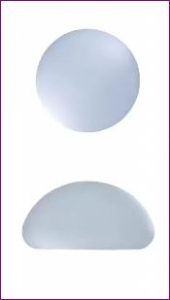
2. Anatomical breast implants:
- These have a teardrop shape and resemble the natural shape of a breast more closely.
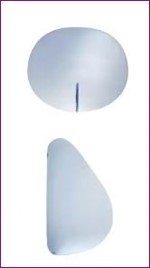
3. Ergonomic implants:
- These change shape depending on whether you are standing (teardrop shape) or lying down (round shape).
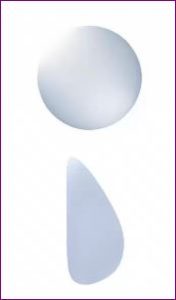
4. Newest generation Ergonomix2 Joy breast implants
The Ergonomix2 Joy breast implants belong to the latest generation of implants. Here’s what makes these advanced breast implants so unique:
Natural Look, Feel, and Movement
The Ergonomix2 Joy breast implants are the softest breast implants currently available. They are made from the latest generation of silicone gel, making them more elastic and softer than ever before. These implants not only feel natural but also provide a natural look, just like real breasts.
Thanks to the advanced design, the implants adapt to your body’s movements: they have a rounder shape when lying down and take on a naturally shaped teardrop form when standing.
Smaller scar and faster recovery
The Ergonomix2 Joy breast implants are highly compressible without the risk of rupture. This means that we can make a smaller incision for the placement of the implants, resulting in a smaller scar and faster recovery.
Safer than ever
The shell of the Ergonomix2 Joy implants is made from an innovative nanostructure, which is the thinnest shell of any breast implant on the market. This reduces the risk of complications, such as capsular contracture, compared to traditionally textured or smooth implants.
More security and warranty options
The manufacturer of the Ergonomix2 Joy breast implants offers additional warranties. This ensures that you can choose these advanced implants with complete confidence. Ask about it during your consultation for more details.
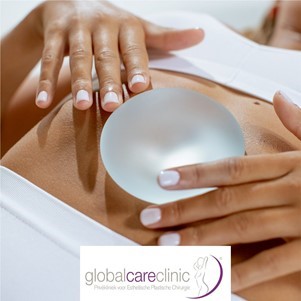
More than just the shape: the number of cc and the profile of the breast implant
Choosing the right implant goes beyond just the shape. The number of cc (size) and the profile of the implant also play a crucial role in the final result. During your consultation, we will discuss these factors to choose the best implant for your body type and desires. Read more in the other FAQ.
4. Which implant profile can I choose? What do mini, demi, full, or corsé mean?
Profile or projection of the breast implant
When choosing a breast implant, in addition to the size (cc amount) and shape, it is also important to determine the desired profile or projection.
The profile or projection refers to the distance between your internal chest wall, and thus has nothing to do with the height of the breasts.
The right profile ensures that the result is balanced and proportional, fitting your body shape.
For this reason, during the breast augmentation consultation, we will take measurements of your breasts (chest).
Different projection levels
There are four different projection levels:
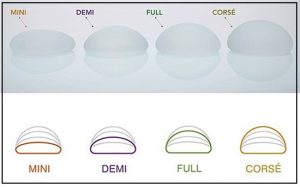
- Mini = low projection
- Demi = average low projection
- Full = average high projection
- Corsé = highest projection
More than just the profile: the number of cc and the shape of the breast implant
Choosing the right implant goes beyond just the profile. The number of cc (the size) and the shape of the implant also play a crucial role in the final result. During your consultation, we will discuss these factors to choose the best implant for your body type and preferences. Read more in the other FAQ.
5. Which filling for the breast implant should I choose? Silicone, saline, gel,…? What is cohesive silicone gel?
Breast implants can be filled with various materials: silicone, but also, for example, saline solution or hydrogel.
Cohesive silicone gel
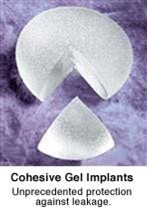
Plastic surgeon Dr. Nelissen consciously chooses breast implants filled with cohesive silicone gel for several important reasons. Below, you can read why these implants are preferred.
1. Safety: Lower risk of leakage
Breast implants filled with cohesive silicone gel offer a high level of safety. The risk of leakage is minimized for the following reasons:
Viscous consistency: Unlike traditional silicone implants, this gel has a thicker and more stable consistency. This makes the gel less prone to leakage.
Monobloc shell: The shell of these implants is monobloc, meaning the filling material and the shell form a seamless, fused whole. This strengthens the integrity of the implant.
No leakage in case of rupture: If puncture or rupture (tear) were to occur, for example due to an accident, the gel stays inside the implant. It will not leak or spill into the body, greatly enhancing safety.
2. Natural look, feel and movement
This latest generation of cohesive silicone breast implants offers an incredibly natural appearance. They are designed in such a way that they are barely distinguishable from real breasts, both in look and feel:
Soft and smooth: These implants feel like real breasts, soft and smooth.
Movement: They adapt seamlessly to your body’s movements. When you lie down, they take on a rounder shape, while in a standing position, they assume a naturally shaped teardrop form. This means they no longer need to be placed entirely under the muscle, making breast augmentation much less painful or even pain-free.
3. Long-lasting durability and low risk of complications
Cohesive silicone gel implants have a long lifespan and are designed to last longer. The risk of hardening or capsular contracture is less than 0.5%, making them very reliable.
4. Additional warranty:
For even more peace of mind, the manufacturer offers an additional warranty on these implants. Ask about it during your consultation.
6. Should I choose a smooth, textured, or polyurethane implant? What is Smoothsilk?
A commonly overlooked aspect when choosing breast implants is the surface of the prostheses. Plastic surgeon Dr. Nelissen prefers implants with a textured or polyurethane surface over smooth implants. This offers several advantages:
1. Lower risk of capsular contracture
- Capsular formation is a normal part of the healing process. When an implant is placed in the body, the body treats it as a foreign object (just like a knee prosthesis or a pacemaker). To prevent the implant from being “rejected” or displaced, the body forms a protective capsule of collagen fibers around the implant. This is a natural process and usually occurs without problems in most patients. However, if this protective capsule begins to contract abnormally and thickens, this indicates a capsular contracture.
- Capsular contracture (also called capsular formation problems) refers to abnormal healing where the scar tissue around the implant tightens, causing the implant to compress, with possible consequences: pain, deformation, and hardening of the breasts.
Our breast implants have a very low rate of capsular contracture (0.5%) thanks to the uniquely designed low-inflammatory surface of the shell, called SmoothSilk. This patented surface significantly reduces the risk of capsular contracture.
Additionally, the manufacturer provides an extra warranty against breakage (during the lifetime of the prosthesis) and a product replacement in case of capsular contracture (Baker grade III and IV) (for a period of 10 years).
2. Lower risk of tilting
- Finally, anatomical polyurethane implants are less likely to tilt (rotate) or move, thanks to the so-called “Velcro effect,” a special foam layer that firmly attaches to the surrounding tissue. This makes them an excellent choice for patients with previous capsular problems or thin, loose skin.
7. Is the implant placed in front of or behind the muscle? What does subfascial placement mean? What does "dual plane" mean?
A frequently discussed topic among patients is whether their implants were placed “in front of or (partially) behind the muscle“.
In front of or (partially) behind the muscle?
There are different options for implant placement, depending on the type of implant, the desired enlargement, and your body proportions (body type):
- In front/above the muscle (subfascial): The implant is placed under the fascia (connective tissue) but above the chest muscle.
- Partially behind/under the muscle (dual plane): The implant is placed partially under the chest muscle and partially under the breast tissue.
- Behind the muscle: The implant is placed entirely under the chest muscle.
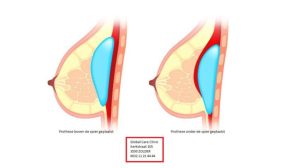
Plastic surgeon Dr. Nelissen keeps up with the latest developments and techniques in breast augmentation, partly through attending conferences and guest surgeries with renowned colleagues. As a result, he often prefers subfascial placement in front/above the muscle for the type of implants he uses. Of course, there are always situations where another placement may be more suitable, depending on the patient’s body structure or existing breast tissue. Therefore, the choice of implant placement (in front or behind the muscle) is always made in consultation with the patient during the consultation.
Advantages of subfascial placement above/over the muscle:
- Smoother and less painful recovery.
- More natural result because the implant moves with the natural breast tissue. With modern ergonomic gel implants, the implant often feels like a natural part of the breast.
- Less chance of a “double bubble,” which is a double fold caused by the natural breast tissue sagging over the implant.
8. Are breast implants safe? What are the disadvantages of breast implants?
The safety of breast implants is more important than ever. Fortunately, significant improvements have been made in the technology and safety of implants over the past 10 to 20 years.
Below, we discuss some crucial safety aspects you should know when considering breast implants. We also refer to the Surgical instructions as provided by the Dutch Society for Plastic Surgery.
1. Silicone breast implants
- Silicone breast implants are the most commonly used type for breast augmentations.
- Silicone is widely used in the medical field due to its versatility and safe properties.
- Some examples of medical devices that also use silicone include: catheters, pacemakers, eye lenses and contact lenses, intrauterine devices (contraceptive devices placed in the uterus).
2. Safest implant brand on the market
- Plastic Surgeon Dr. Nelissen only uses A-brand breast implants, of the highest quality, currently at the forefront of research and guarantees absolute safety.
- These breast implants have extremely strict FDA (U.S. Food and Drug Administration) approval, which is very unique for breast implants.
- This FDA approval is the result of the most rigorous clinical study on breast implants ever conducted according to FDA guidelines. Furthermore, the FDA imposes strict follow-up on further studies regarding the safety of these breast implants, including risks of capsular contracture and rupture.
- The study shows that our breast implants are not only safe but also achieve exceptional results regarding capsular contracture and rupture.
3. Infection
- Infections can occur after any type of surgery, even when strict sterile conditions are maintained. In some cases, an infection may require the removal of the breast implant.
- However, treatments in a private clinic offer a lower risk of infection, as the clinic is free from hospital germs and hospital bacteria that are often present in public hospitals.
- The risk of infection significantly increases with smoking. Therefore, we ask that you stop smoking at least 4 weeks before and 4 weeks after the procedure.
4. Leaking of implants
- We prefer implants made of cohesive silicone gel. The risk of leakage problems is minimized because this gel is not liquid and forms a monobloc (i.e., it forms a single unit with the shell).
- In the event of a puncture or rupture of the implant, for example due to an accident, the gel will remain inside the implant and will not leak or spill into the body.
5. Capsular contracture
- Capsular contracture (also known as capsule formation issues) refers to an abnormal healing process where the scar tissue around the implant tightens, causing the implant to compress. Potential consequences include: pain, deformation, and hardening of the breasts.
- Our breast implants have a very low rate of capsular contracture (0.5%) thanks to the uniquely designed low-inflammatory surface (the patented SmoothSilk) of the shell.
- These implants are also covered by a lifetime fracture guarantee for the prosthesis and a product replacement policy for capsular contracture (Baker grades III and IV) for a period of 10 years.
- Dr. Nelissen also uses the “minimal invasive breast surgery” technique, where the breast augmentation procedure is performed with as little damage to surrounding tissues and muscles as possible. This results in faster and less painful recovery and reduces the long-term risk of complications such as capsular contracture.
6. BIA-ALCL
In the past decade, the very rare condition BIA-ALCL (“Breast Implant Associated Anaplastic Large Cell Lymphoma”) has been linked by some to certain types of breast implants.
In the past decade, the very rare condition BIA-ALCL (“Breast Implant Associated Anaplastic Large Cell Lymphoma”) has been linked by some to certain types of breast implants.
- This condition has gained attention in the (social) media, despite being extremely rare: in 2019, around 600 cases were reported worldwide among an estimated 40 million women with breast implants, which is 0.0015%.
- According to the U.S. FDA, BIA-ALCL is a rare condition that has only been identified in patients with breast implants that have a textured surface. The FDA has established a tracking system for this type of breast implant.
- The breast implants we use are strictly monitored as part of their FDA approval. So far, no cases of BIA-ALCL have been reported with these implants.
Common symptoms of BIA-ALCL include unexplained pain, asymmetry, lumps in the breast or underarm, rash, breast hardening, or significant fluid accumulation. Patients experiencing these or other symptoms are advised to consult their doctor for evaluation.
7. Breast Implant Illness (BII)
Some women report autoimmune-like symptoms such as fatigue, joint pain, or rashes, which are sometimes referred to as “Breast Implant Illness” (BII). However, there is no scientific evidence confirming a direct link between breast implants and these symptoms.
8. Regular check-up
- Breast implants are foreign objects, just like hip prostheses, knee prostheses, pacemakers, etc.
- Therefore, it is recommended to have the breast implants regularly checked with MRI or ultrasound. Even if you are not concerned about the condition of your implants, it is important to undergo routine screenings. These checks can help determine whether the implant is still intact and can identify complications such as rupture or silicone leakage. While ruptures can cause various symptoms, some women with ruptured implants experience no symptoms, making routine screenings crucial for detecting potential damage.
- This check-up may be performed during the recommended preventive breast cancer screening.
9. Traceability
For traceability, we offer the following services:
- Implant registration: All placed breast implants are registered.
- Implant card: During the second postoperative check-up, every patient will receive an implant card containing all relevant details such as the serial number, manufacturer’s name, and other specifications of the implant. This can be useful in case of later complications or prosthesis exchange.
- Built-in chip: Some breast implants come equipped with an embedded identification number that can only be read by the plastic surgeon using a special scanner. This allows, in case of complications, to easily determine which type of implant you have (including volume and diameter) without the need to remove the implant.

All questions about breast augmentation surgery: preparation, aftercare, and recovery from a breast augmentation - Risks and complications.
1. How does the breast augmentation surgery proceed?
A breast augmentation at Global Care Clinic always takes place:
- in one of our modern operating rooms.
- under general anesthesia by our regular anesthetist.
- as a day procedure: You can go home on the same day.
Click here for a 3D animation video of a breast augmentation with implants, developed by the American Society for Plastic Surgeons.
We would also like to refer you to our page about the course of your surgery, where you can read all the detailed steps before, during, and after your surgery, as well as the further questions on this page, such as:
- Will I have a lot of pain after my breast augmentation?
- How long should I take off?
- How can I prepare for my breast augmentation?
2. What is the Preservé breast augmentation?
3. Pain after a breast augmentation: Will I have a lot of pain after a breast augmentation? How long does pain last after a breast augmentation?
Will I have a lot of pain after my breast augmentation?
- Immediately after the surgery, our patients wake up pain-free, and some even ask, “when will the surgery begin?“
- In the first few days after the surgery, some stiffness and a feeling of pressure may occur, similar to muscle soreness. This is usually well controlled with painkillers. It is important to strictly follow our medication schedule. It is better to prevent pain by taking the prescribed pain medication at the scheduled times.
- As a result, some patients can return to work on Monday after a breast augmentation on Thursday.
Why do our patients experience less pain?
Patients of Dr. Nelissen typically experience very manageable pain, and this is due to several factors that contribute to a more comfortable recovery:
The choice of (size or type) of breast implant: The more natural the breast implant, the less discomfort you will experience. By choosing a breast implant that fits well with your body, recovery is quicker and virtually pain-free. This is also why Dr. Nelissen is not a fan of disproportionately large breast implants.
The placement of the breast implant: With the subfascial placement of the breast implant, there is often less pain than with the traditional placement behind the muscle. This makes recovery significantly more comfortable.
Modern surgical techniques: Thanks to the latest surgical techniques, such as Minimal Invasive Augmentation (MIA) and Preservé breast augmentation, internal trauma and bleeding are minimized as much as possible, which helps to reduce pain. This technique also lowers the risk of excessive scarring and complications like capsular contracture.
Effective pain management: By carefully following our prescribed medication schedule and maintaining continuous communication with the patient, who can always contact us in case of unexplained or increased pain, we can adjust pain management to each patient’s individual pain threshold.
4. How many days should I take off after a breast augmentation? How long can I not work after a breast augmentation? Do I need to take complete rest? How long should I arrange for a babysitter? When can I start exercising again?
Recovery time after breast augmentation

We understand that, as a patient, you often have a busy social, professional, and family life. Therefore, we often receive the following questions:
- How many days off should I take after a breast augmentation?
- When can I start exercising again?
- Can I lift my children again?
- When can I drive again?
- Can I do anything to speed up my recovery?
While recovery can vary from patient to patient, it is good to know that the recovery time for our breast augmentations is relatively short. Most patients can resume their daily routine the day after surgery, such as driving, getting dressed, and picking up children from school. Within a week, most patients are back to work.
This quick and almost painless recovery after breast augmentation is due to the application of our “Flash Recovery” or “24h Recovery” technique.
What is the “Flash Recovery” or “24-hour Recovery” technique?
This advanced technique for breast enlargement allows patients to resume their daily activities almost immediately after the procedure.
With this technique, you opt for minimal disruption to your daily life and need to take fewer vacation days.
Dr. Nelissen has been successfully applying this technique for over 10 years, following the new standard in breast surgery.
Do I not have to rest for 6 weeks after my breast augmentation?
Traditional, though now outdated, guidelines often recommend prolonged immobility for 6 weeks after breast augmentation, after which patients are suddenly allowed to do everything again.
However, new studies show that patients will heal faster if they perform specific exercises before and after the surgery.
We also see this in other medical disciplines, such as hip surgeries, where patients are quickly taken out of bed by a physiotherapist to get moving again shortly after the procedure.
What are the pillars of the “Flash Recovery” or “24-hour Recovery” technique?
- Implant size: By choosing an implant that fits well with your body, recovery is often faster and without noticeable pain. This is also the reason why Dr. Nelissen is not in favor of disproportionately large breast implants, as they place excessive strain on the surrounding tissue.
- Modern intravenous anesthesia: We use the latest anesthetics to prevent postoperative discomfort. Our anesthesia is also specialized for day-case patients.
- Personalized medication plan: We create a tailor-made medication plan. We also maintain an open line of communication with the patient (who can always contact us if there is unexplained or increased pain), allowing us to continuously adjust pain management to the individual’s pain threshold, which varies for each patient. With less pain and discomfort after the surgery, recovery is not only faster but also more comfortable. The use of dissolvable stitches also makes it less bothersome for the patient.
- Active cooperation of the patient: Part of the quick and painless healing is in the hands of the patient themselves, requiring their active cooperation through daily exercises, which are best started 2 weeks before the surgery.
- Special surgical techniques “Minimal Invasive Augmentation (MIA)” and “Preservé breast augmentation”
How do the special surgical techniques “Minimal Invasive Augmentation (MIA)” and “Preservé breast augmentation” work?
These techniques focus on controlling internal bleeding (prospective hemostasis) and avoiding trauma (to surrounding tissues and muscles), resulting in less swelling and pain, by using:
- Fine instrumentation
- Gentle (bloodless) dissection: The breast tissues are carefully separated without unnecessary damage or tears, creating space for the breast implant. This “gentle tissue handling” reduces pain and promotes recovery.
- Avoiding contact with the ribs during implant placement (if needed, implant placement using the No-touch sleeve technique)
- Additional local anesthesia to the operated area during dissection
- Dissection under direct view of the surgical area (not via the armpit)
- Careful and prospective hemostasis (= controlling bleeding during dissection and surgery): We operate “dry” to prevent bleeding and bruising, as these are the main causes of the pain many patients experience after breast augmentation (or other surgeries).
- Therefore, there is no need for (uncomfortable) drains to remove blood through tubes after the surgery.
- Minimal incision: A very small incision is made in the natural breast fold underneath the breasts, minimizing the visibility of a scar (“Minimal scar”). When properly cared for and followed up after the surgery (during the included check-up appointments), the scar will fade to an almost invisible line after a year. This minimal incision of about 2.5 cm is half the size of an incision in traditional breast augmentation.

See below a photo of the scar approximately 1 year after the breast augmentation performed by Dr. Nelissen at the Global Care Clinic. After about 1 year, the scar has faded into a nearly invisible, thin, skin-colored line.

Postoperative instructions
After the procedure, it is important to:
- Avoid heavy physical activities (such as extreme sports or heavy lifting) for 3 to 4 weeks. This can be gradually resumed based on your own feeling.
- Perform gentle exercises for the arms to keep the chest muscles flexible.
- Attend regular follow-up appointments to closely monitor the healing process together.
5. Why do I have to wear a sports bra after my breast augmentation?
After a breast augmentation, wearing a postoperative bra or sports bra is important for proper healing and optimal results.
Here are the main reasons:
- Support and stability: A sports bra provides the right support for the new implants, keeping them in place and preventing shifting during the first sensitive weeks after the procedure.
- Reduction of swelling and pain: By securely and comfortably surrounding the breasts, a sports bra helps reduce swelling and discomfort, benefiting the healing process.
- Protection of incisions: The compression and structure of a sports bra protect the wounds and scars, promoting faster and safer healing of the incision edges.
- Promotion of a beautiful shape: A sports bra helps shape and maintain the breasts in the correct position, which is important for an even and aesthetic result.
It is generally recommended to wear a sports bra day and night during the first weeks after surgery.
The price of your breast augmentation includes 1 postoperative sports bra (worth €85).
6. Will I be prescribed painkillers?
Pain management after your breast augmentation: our medication plan
After your breast augmentation, it is important to strictly follow the prescribed medication plan to prevent pain. This may mean setting an alarm in the first few nights to take your medication on time. Don’t wait for the pain to start, but take the pain medication preventively according to the schedule.
Tip! It is helpful for you to note down when you take which medication each time, so you keep track and follow the schedule accurately.
What should you have at home for pain management?
We do not provide pain medication after the surgery, so make sure you have enough pain medication at home, both paracetamol and ibuprofen. However, do not use aspirin! If you have a sensitive stomach, you might consider using suppositories for extra comfort.
Worried about pain medication and addiction?
Some patients are concerned about using painkillers and the possible risk of dependence or addiction. However, the prescribed medication plan has been carefully designed to gradually reduce the medication. This minimizes the risk of addiction. Additionally, the painkillers we prescribe are not extremely strong and can even be purchased at the pharmacy without a prescription.
Adjustments to your pain management
If you experience unexpected or unexplained pain, we are always here for you. You can reach us by phone or message, and we will adjust the pain management to your personal pain threshold.
7. Do I need to stay overnight at the Global Care Clinic? When can I go home? What is day hospitalization?
At the Global Care Clinic, all surgeries are performed on a day admission basis (day hospitalization).
What is day hospitalization?
Day hospitalization means that you are admitted on the day of the surgery and can go home on the same day. You stay in the clinic for just a few hours, with no overnight stay required. After the procedure, you will remain under observation in the recovery room for a sufficient amount of time. Once you are fully awake and both the plastic surgeon and the anesthesiologist give their approval, you can go home with your companion.
Advantages of day hospitalization
The advantages of day hospitalization are:
- Your recovery takes place in your own home environment, where you feel most comfortable.
- No additional cost for an overnight stay in the hospital.
Conditions for day hospitalization:
Day hospitalization is possible thanks to:
- Our years of experience with optimal pain management and minimally invasive surgery: This allows you to quickly get back on your feet after surgery. Day hospitalization is becoming increasingly common, even in public hospitals, and is also known as “Flash Recovery,” “24-Hour Recovery,” or “Enhanced Recovery After Surgery (ERAS).” See also our question: How long do I need to recover after a breast augmentation?
- Our anesthesia, specialized in day hospitalization.
- Our excellent aftercare and follow-up, where we are available 24/7 for any questions or complications after the procedure.
8. How often do I need to come for a check-up?
We consider it essential to carefully monitor the healing process. That’s why all follow-up appointments after a breast augmentation are included in the price.
We will schedule at least four check-ups after a breast augmentation: after 1 week, within a month, after 3 months, and after 1 year.
This allows us to evaluate each stage of your recovery together and make timely adjustments if necessary. It provides both of us with the assurance of optimal care throughout the entire journey.
9. What are the possible risks and complications of a breast augmentation?
As with any surgery, there are potential risks associated with a breast lift. Read more about the general complications that can occur with any surgical procedure.
During the consultation, the plastic surgeon will discuss all questions regarding specific risks and possible complications with you in detail. These are also clearly stated in the pre-operative documents, which you must read carefully and sign.
Specifically for breast augmentation with implants, it is important to know that existing differences between the breasts, such as asymmetry, nipple height, or a loose skin envelope, are not automatically corrected. Additional procedures and extra scars may be necessary to address these irregularities.
We also refer to the Surgical Information Leaflet as issued by the Dutch Society for Plastic Surgery.
Also see our FAQ – Are breast implants safe?
10. How long can a breast implant stay in place? When should I replace or remove my breast implant?
Breast implants do not have an expiration date, but they also do not last forever.
Whether and when you should remove or replace your breast implants depends on individual factors such as:
- your age,
- your health/lifestyle,
- your personal preferences, and
- the expertise of your plastic surgeon.
Read more here about implant replacement and reasons to have breast implants exchanged.
11. What warranty do I get on my breast implants?
Our breast implants are covered by the manufacturer with:
- A lifetime warranty against implant rupture and
- A product replacement policy for capsular contracture (Baker grades III and IV) for a period of 10 years.
Ask about this during your consultation.
Do you have any other
questions about
breast augmentation?
Would you like to discuss whether breast augmentation might be right for you? Then schedule your free consultation and discover your options with complete confidence.
